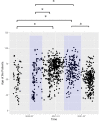The Vicissitude of Do Not Attempt Cardiopulmonary Resuscitation (DNACPR) Order During COVID-19 Pandemic in Japan - A Retrospective Cohort Study
- PMID: 35431574
- PMCID: PMC9012304
- DOI: 10.2147/IJGM.S361582
The Vicissitude of Do Not Attempt Cardiopulmonary Resuscitation (DNACPR) Order During COVID-19 Pandemic in Japan - A Retrospective Cohort Study
Erratum in
-
Erratum: The Vicissitude of Do Not Attempt Cardiopulmonary Resuscitation (DNACPR) Order During COVID-19 Pandemic in Japan - A Retrospective Cohort Study [Corrigendum].Int J Gen Med. 2022 May 2;15:4525-4526. doi: 10.2147/IJGM.S371863. eCollection 2022. Int J Gen Med. 2022. PMID: 35528287 Free PMC article.
Abstract
Introduction: Japan went through five surges of coronavirus disease 2019 (COVID-19) or "waves". However, their impacts on the do not attempt cardiopulmonary resuscitation (DNACPR) of the patients are not known.
Methods: A retrospective single-center cohort study was conducted for all hospitalized patients with COVID-19 from March 1, 2020, to September 30, 2021. Their code status was retrieved, and its association with the waves and other parameters, such as in-hospital mortality, was investigated. The relationship between DNACPR status and each wave was examined, as well as the effect on in-hospital mortality.
Results: A total of 1153 patients were hospitalized with the diagnosis of COVID-19 during the study period. On admission, 117 patients (10.1%) had DNACPR orders, 373 patients (32.4%) were on full code, 45 patients (3.9%) stated that they cannot decide code status. DNACPR rate appeared to increase at the summit of each wave. Subsequently, 160 patients (13.9%) became DNACPR status, 385 patients (33.4%) became full code, and 12 patients (1.0%) stated that they remained unable to decide code status. There was no association between DNACPR status and each wave, and DNACPR status was not associated with higher mortality (P = 0.87), both by logistic regression analysis.
Conclusion: DNACPR status among hospitalized COVID-19 patients appeared to have changed over multiple waves in Japan, but it is more likely due to the change of the patients' demographics, particularly their age. DNACPR was common among the elderly, but it was not independently associated with higher mortality.
Keywords: COVID-19; DNACPR; Japan; do not attempt cardiopulmonary resuscitation.
© 2022 Morishita and Iwata.
Conflict of interest statement
The authors report no conflicts of interest in this work.
Figures




Similar articles
-
Code status orders in hospitalized patients with COVID-19.Resusc Plus. 2023 Aug 23;15:100452. doi: 10.1016/j.resplu.2023.100452. eCollection 2023 Sep. Resusc Plus. 2023. PMID: 37662642 Free PMC article.
-
Documentation of Do-Not-Attempt-Cardiopulmonary-Resuscitation orders amid the COVID-19 pandemic.Age Ageing. 2021 Jun 28;50(4):1048-1051. doi: 10.1093/ageing/afab075. Age Ageing. 2021. PMID: 33909020 Free PMC article.
-
Bringing into focus treatment limitation and DNACPR decisions: How COVID-19 has changed practice.Resuscitation. 2020 Oct;155:172-179. doi: 10.1016/j.resuscitation.2020.08.006. Epub 2020 Aug 20. Resuscitation. 2020. PMID: 32827587 Free PMC article.
-
DNACPR decisions during Covid-19: An empirical and analytical study.Med Law Rev. 2022 Feb 23;30(1):60-80. doi: 10.1093/medlaw/fwab047. Med Law Rev. 2022. PMID: 35029676 Free PMC article.
-
DNACPR ('do not attempt cardiopulmonary resuscitation') orders in patients with a fractured neck of femur who lack capacity.Ann R Coll Surg Engl. 2017 Apr;99(4):255-258. doi: 10.1308/rcsann.2017.0020. Ann R Coll Surg Engl. 2017. PMID: 28349757 Free PMC article. Review.
Cited by
-
Change in Code Status Orders of Hospitalized Adults With COVID-19 Throughout the Pandemic: A Retrospective Cohort Study.J Palliat Med. 2023 Sep;26(9):1188-1197. doi: 10.1089/jpm.2022.0578. Epub 2023 Apr 5. J Palliat Med. 2023. PMID: 37022771 Free PMC article.
References
-
- Osaki T. Access denied: virus third wave forces hand of Japan’s medical system [Internet]. The Japan Times; 2021. [cited December 9, 2021]. Available from: https://www.japantimes.co.jp/news/2021/01/19/national/japan-coronavirus-.... Accessed April 7, 2022.
-
- At-home care for infections proved nightmare in fourth wave | the Asahi Shimbun: breaking News, Japan News and Analysis [Internet]. The Asahi Shimbun. [cited October 26, 2021]. Available from: https://www.asahi.com/ajw/articles/14410747. Accessed April 7, 2022.
-
- COVID-19 “5th wave” engulfs hospitals in Tokyo area | the Asahi Shimbun: breaking News, Japan News and Analysis [Internet]. The Asahi Shimbun. [cited December 9, 2021]. Available from: https://www.asahi.com/ajw/articles/14412384. Accessed April 7, 2022.
LinkOut - more resources
Full Text Sources

